Honey Lime Fruit Salad
As an Amazon Associate I earn from qualifying purchases.
This honey lime fruit salad has a mouthwatering combination of strawberries, blueberries, red seedless grapes, mandarin oranges, and pineapple. It’s topped with a honey lime poppyseed dressing that perfectly combines sweet and sour.

❤️Why You’ll Love This Recipe
This is my go-to summertime fruit salad. It’s sweet, refreshing, and easy to make. I love that I can prep it ahead of time (even the day before) and just toss it together when I’m ready to serve it.
Honey lime fruit salad makes an excellent pool-side side dish or contribution to a potluck. It’s more of an adult fruit salad – which I think you’ll love. Don’t get me wrong, my kids like it.
However, this honey lime poppy seed dressing is especially pleasing to my adult palate. It’s not overly sweet and the tartness from the limes makes me want to come back for seconds.
Other fruit salad recipes I have shared are Winter Fruit Salad, Triple Berry Fruit Salad with Poppy Seed Dressing, Watergate Salad, and Thanksgiving Fruit Salad Recipe.
If you’re looking to round out this recipe with other summer-inspired dishes, we recommend Pepperoni Pasta Salad, Grilled Lemon Pepper Chicken, or Chopped Pasta Salad.
📋Ingredients
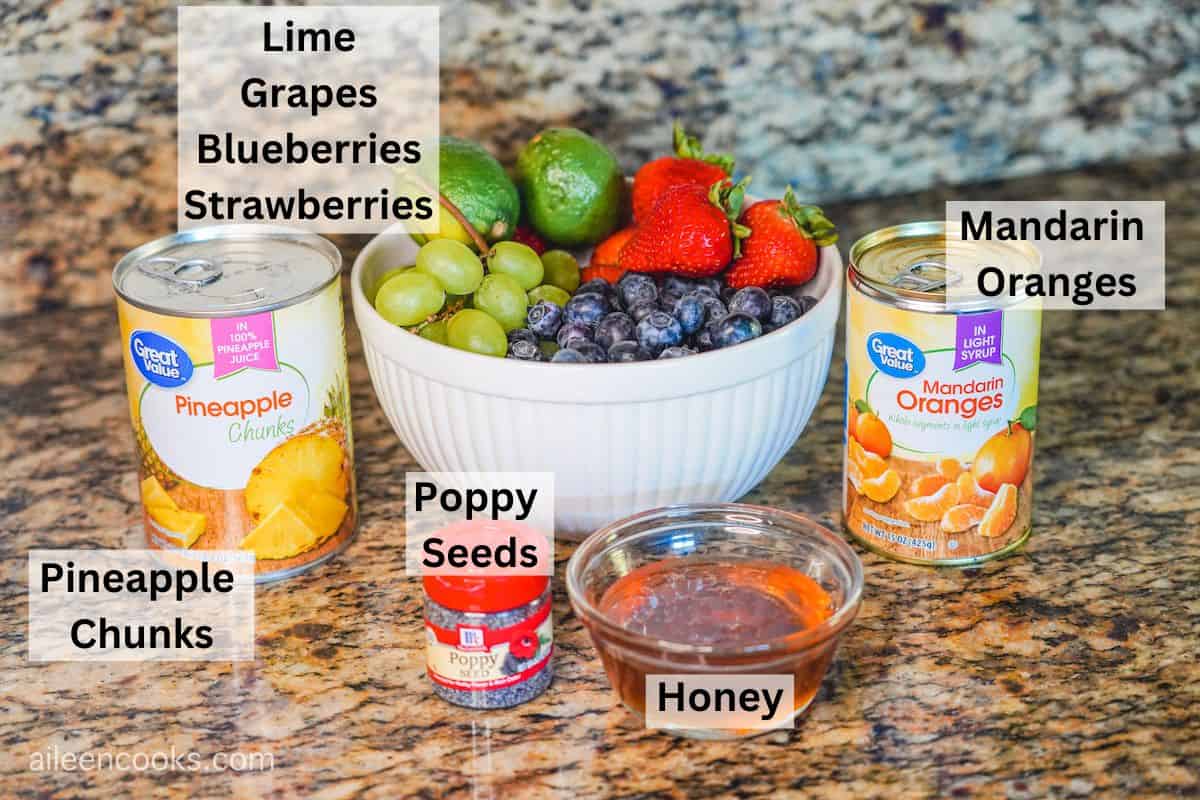
To make honey lime fruit salad, you will need the following ingredients:
Lime: fresh lime is a must-have for this recipe. I recommend at least 2 limes, so you have one to zest and one to juice.
Honey: Make sure your honey is smooth and not crystalized as this will affect the overall taste and texture of the fruit salad.
Scroll to the bottom for the complete list of ingredient measurements and printable recipe card.
📖 Ingredient Swaps
Honey: If for some reason you can’t serve honey, you can substitute it for equal parts agave syrup.
Mandarin Oranges: This recipe calls for canned mandarin oranges but fresh mandarin oranges (often labeled as cuties) may be used.
Poppy Seeds: This is an optional ingredient. Feel free to omit it if you don’t like poppy seeds.
🔪Step-by-Step Instructions

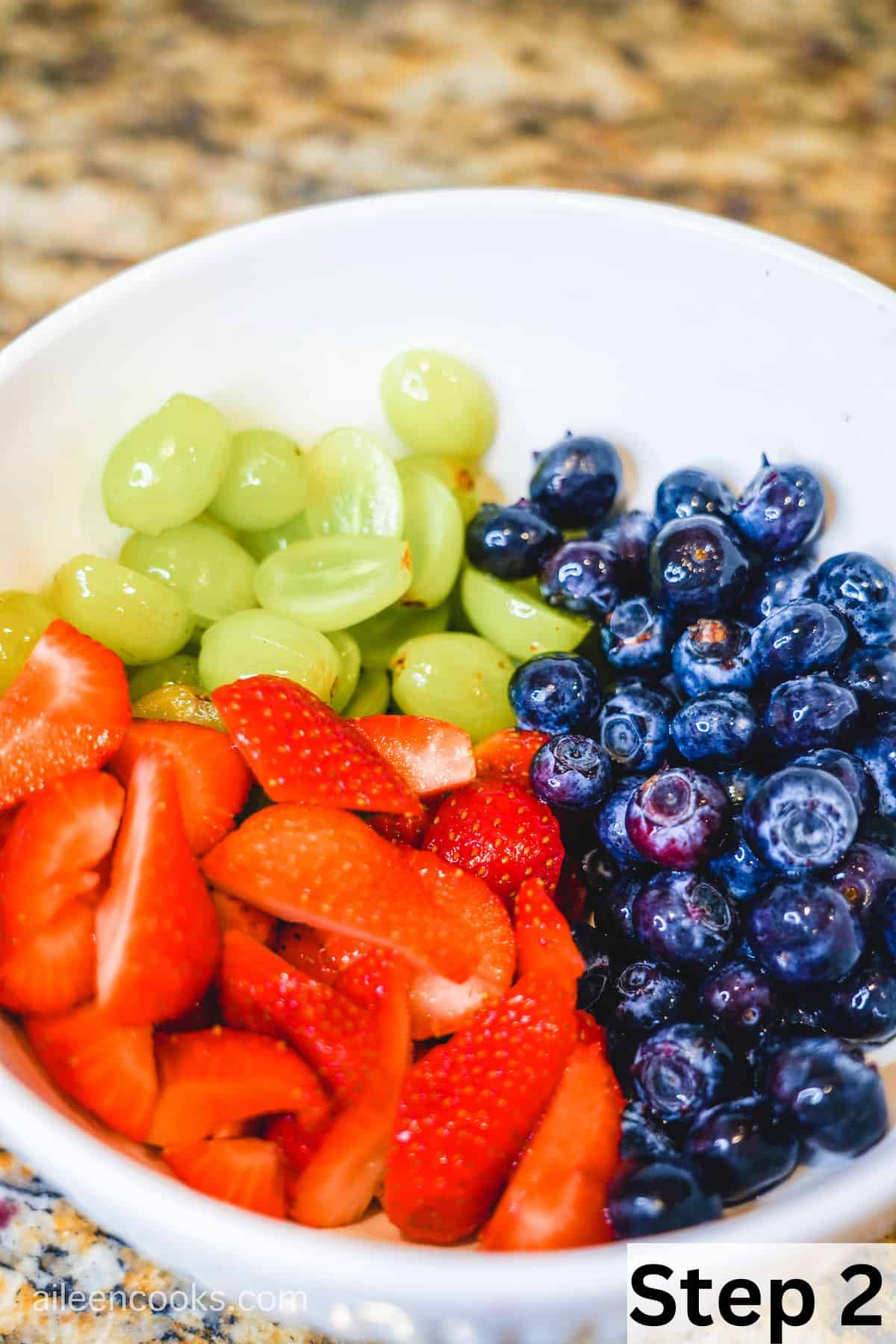
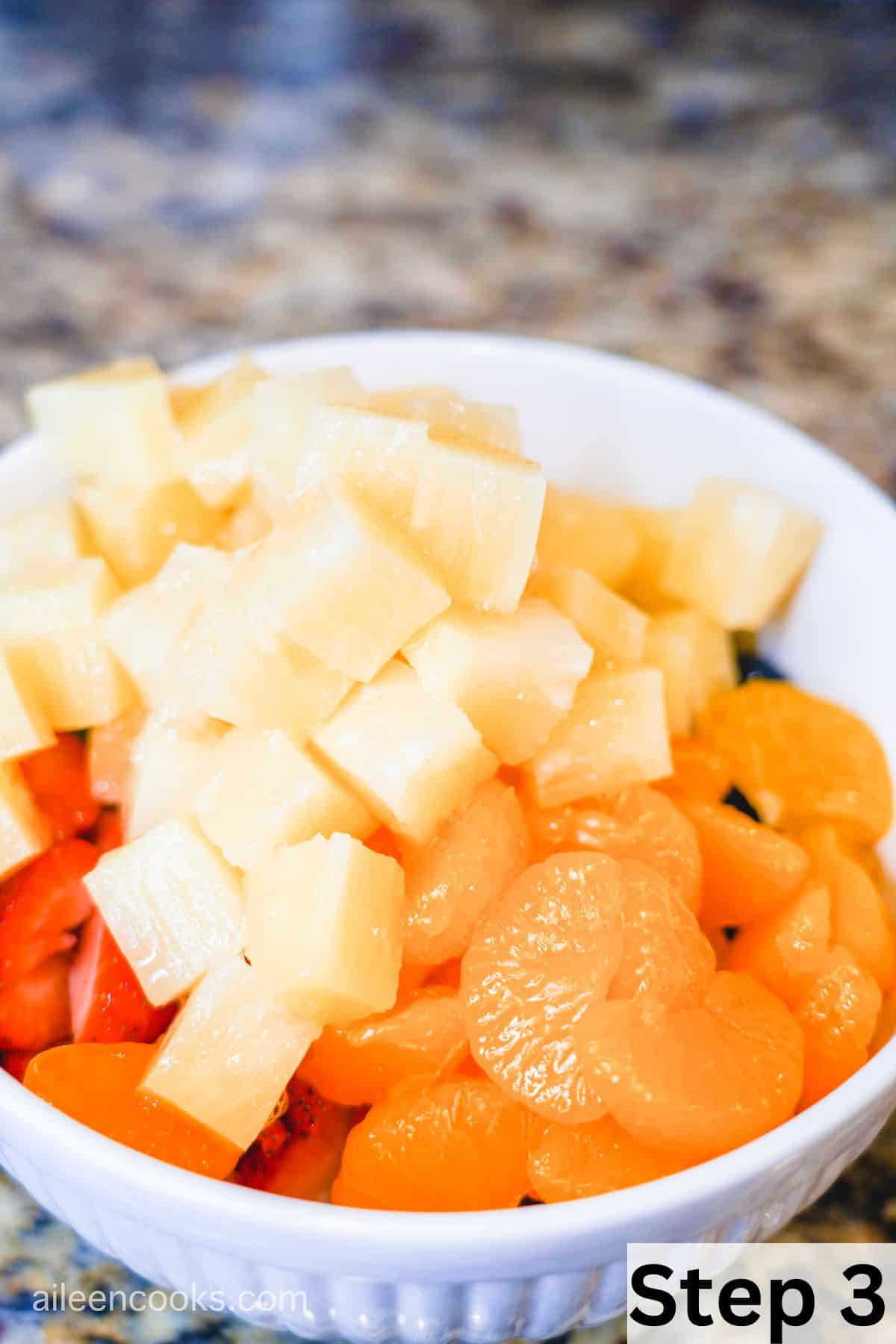
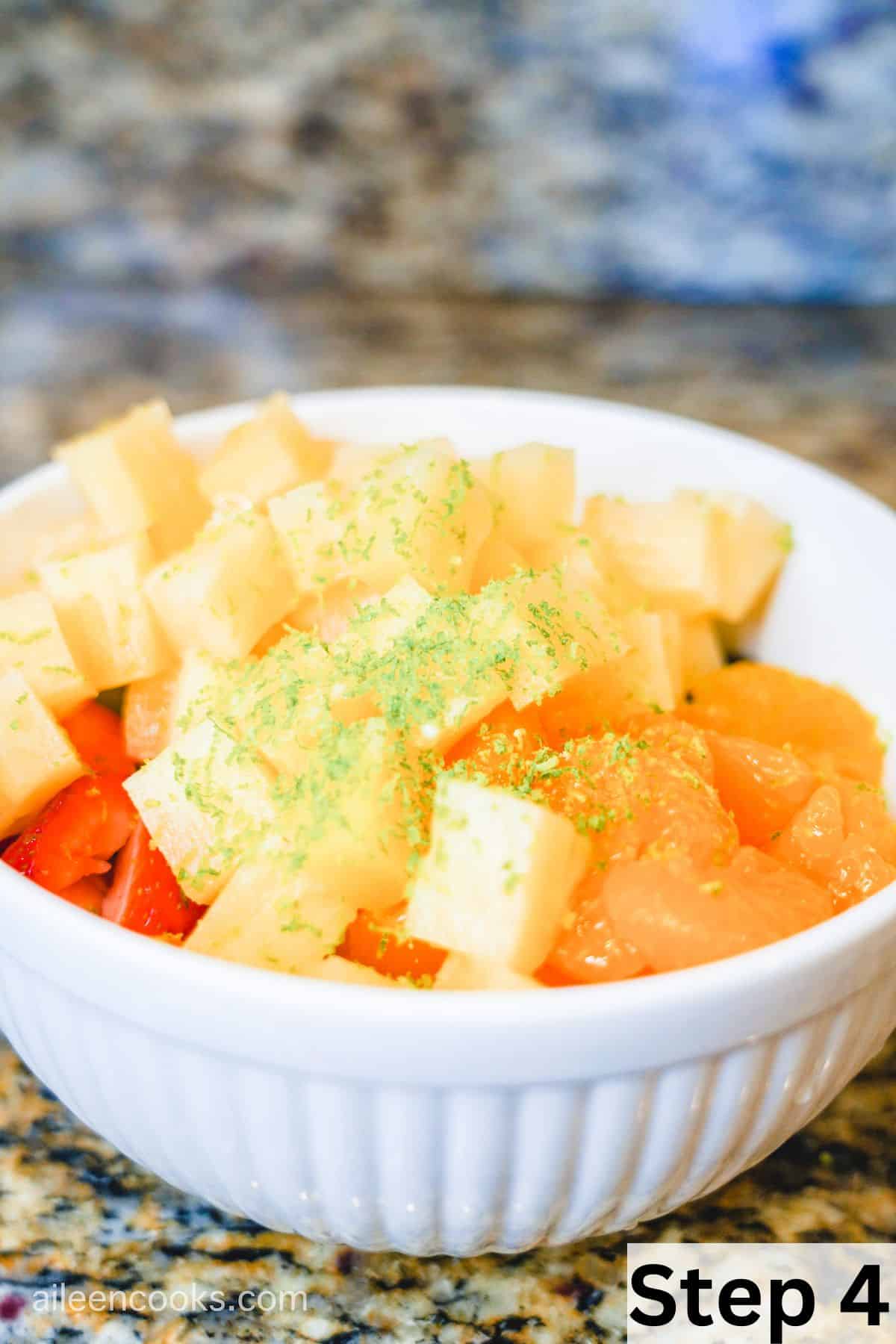
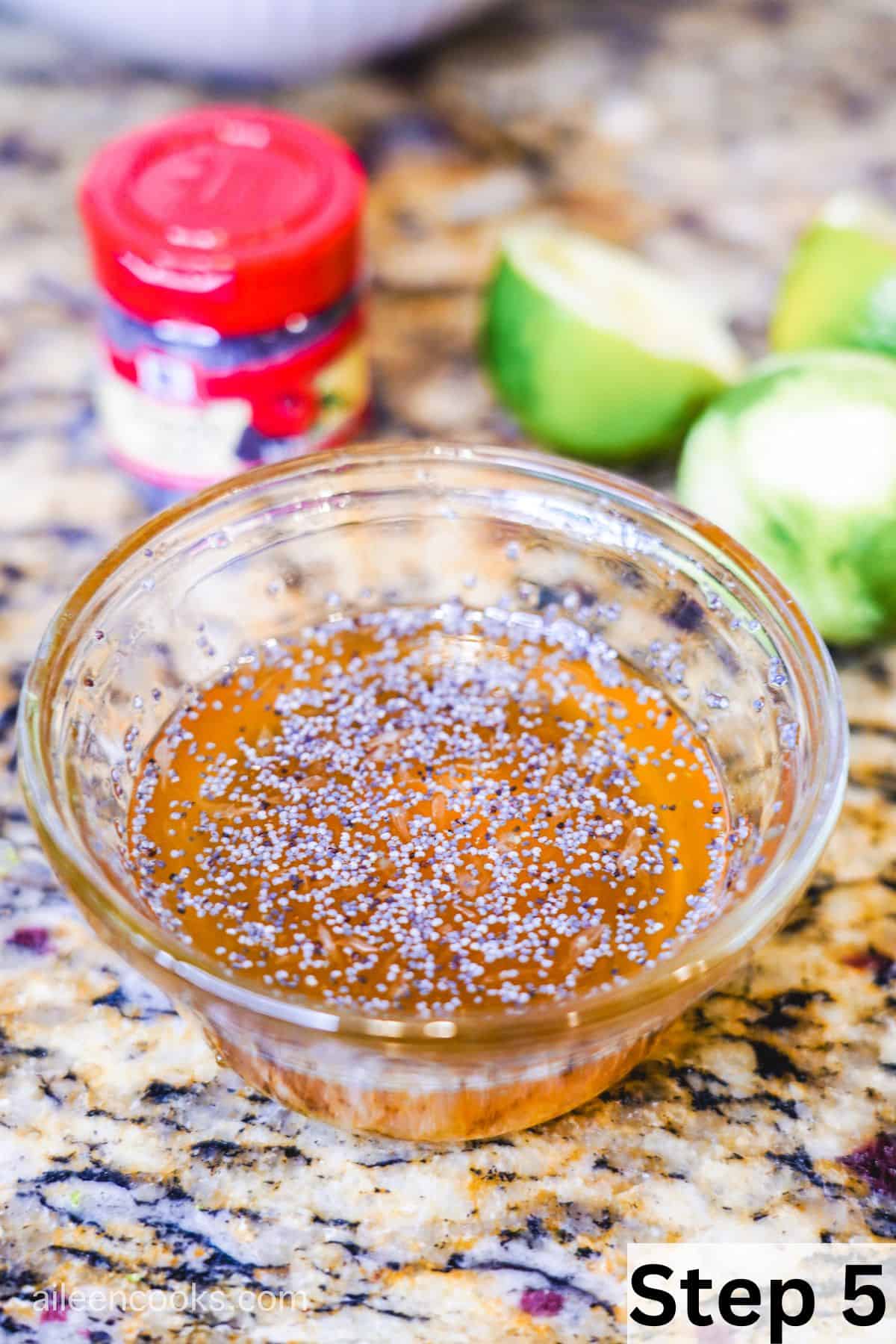
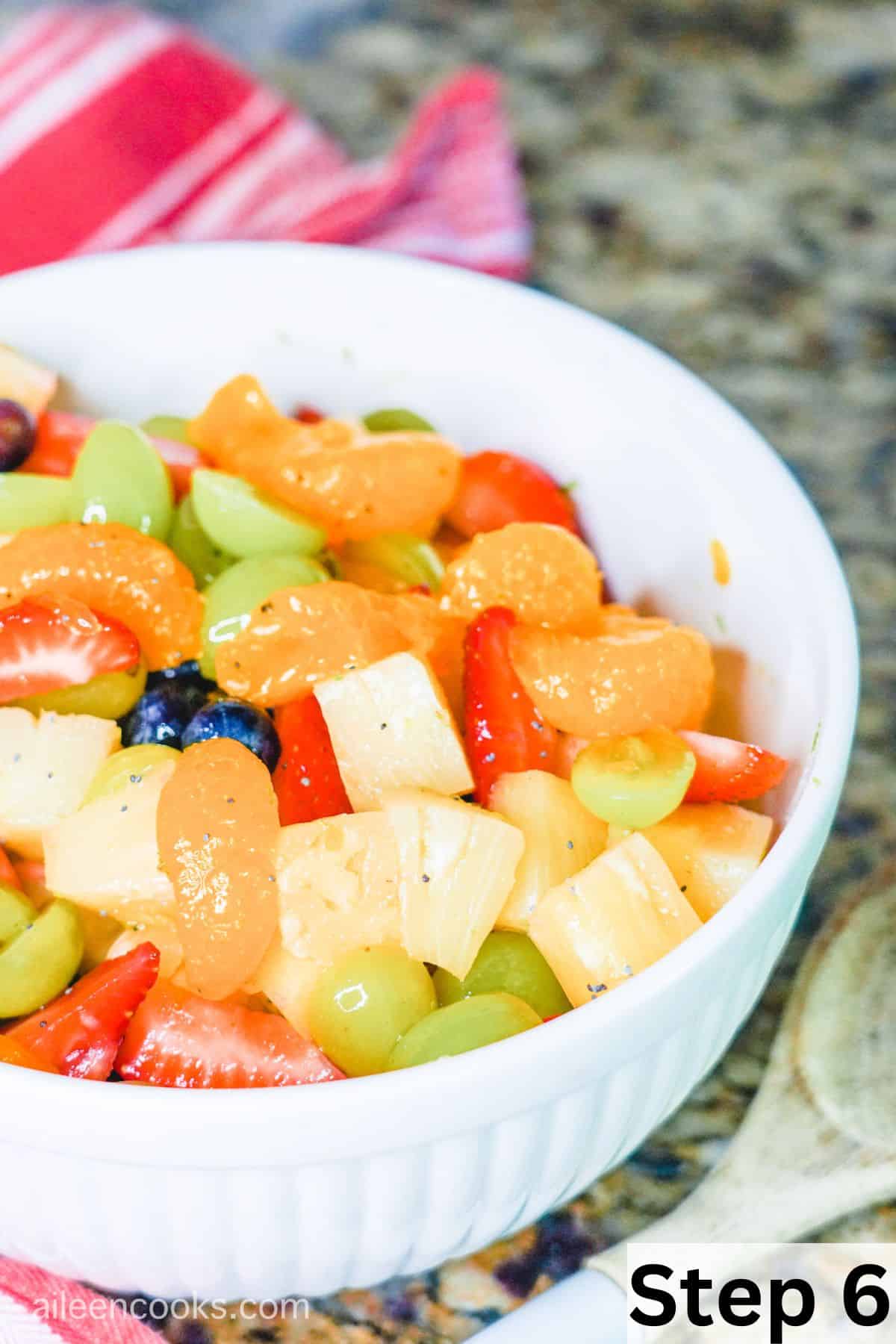
👩🏻🍳Expert Cooking Tips
Whenever you make a dressed salad – whether that is a green salad or fruit salad – you want to wait until the last possible minute to add the dressing. That is especially true with this fruit salad. The dressing (although delicious), is best served on top of the fruit at the time of the meal.
You can make this fruit salad and the dressing ahead of time. Just refrigerate both in separate containers and mix them up right before you eat them.
Unfortunately, the leftovers aren’t great. It really is best eaten on the same day. So plan to load up everyone’s plates with this lip-smacking good fruit salad.
💭Recipe FAQs
When preparing a fruit salad, it’s important to consider the flavors and textures of different fruits to ensure a harmonious combination. While personal preferences can vary, here are a few fruits that are commonly avoided or may not work well together in a fruit salad:
Citrus fruits with milk-based dressings: Citrus fruits such as oranges, grapefruits, or tangerines may not pair well with milk-based dressings or creams as they can curdle the milk and affect the texture.
Soft and delicate fruits with sharp fruits: Soft and delicate fruits like bananas, peaches, or avocados can become mushy and lose their texture when mixed with sharp or acidic fruits like pineapple, kiwi, or strawberries.
Highly fragrant fruits with subtle fruits: Some fruits have strong aromas that can overpower more delicate flavors. Examples include durian, which has a distinct odor, or passion fruit, which has a strong tart flavor. Mixing them with subtle fruits like melons or pears might result in an unbalanced taste.
Very ripe and soft fruits with crisp fruits: If you’re including fruits like melons, apples, or pears, it’s best to avoid mixing them with extremely ripe and soft fruits like berries or stone fruits. The contrast in textures might be unpleasant.
Fruits with different ripening times: Mixing fruits with different ripening times can lead to uneven ripening and spoilage. For example, adding unripe bananas to a fruit salad with ripe fruits might cause the other fruits to ripen too quickly.
Remember that these guidelines are not strict rules, and personal taste preferences should always be considered. Some people may enjoy unique combinations, so feel free to experiment and find what works best for you!
Honey is often added to fruit salad for a variety of reasons:
Sweetness: Honey is a natural sweetener that can enhance the overall flavor of the fruit salad. It adds a pleasant touch of sweetness that can balance out the tartness or natural acidity of some fruits.
Flavor enhancement: Honey has its own distinct flavor profile, which can complement the flavors of different fruits. It adds a hint of complexity and depth to the overall taste of the salad.
Moisture and juiciness: Honey has a syrup-like consistency that can help coat the fruits and retain their moisture. This can prevent the fruits from drying out and keep them juicy and succulent.
Binding agent: Honey can act as a natural binding agent, helping to bring the fruits together and create a cohesive salad. It can help the fruits stick together, especially when mixed with other ingredients like yogurt or dressings.
Nutritional benefits: While honey is primarily used for its taste, it also contains beneficial compounds such as antioxidants and certain minerals. Including honey in your fruit salad can provide some additional nutritional value.
However, it’s worth noting that the decision to include honey in a fruit salad is based on personal preference. If you prefer your fruit salad without added sweeteners, you can omit the honey or explore other natural sweeteners like maple syrup or agave nectar as alternatives.
Lime juice is often added to fruit for several reasons:
Flavor enhancement: Lime juice has a tangy and citrusy flavor that can enhance the taste of fruits. It adds a refreshing and zesty element, especially to fruits that are naturally sweet or bland in flavor.
Preventing browning: When fruits like apples, pears, bananas, or avocados are cut or exposed to air, they undergo a process called enzymatic browning. Browning can negatively affect the appearance and taste of the fruit. Lime juice contains ascorbic acid (vitamin C), which can slow down this enzymatic browning process and help maintain the fruit’s fresh color.
Antioxidant properties: Lime juice, like other citrus fruits, is a good source of antioxidants, primarily vitamin C. Antioxidants help protect the body against oxidative stress and damage caused by harmful free radicals. By adding lime juice to fruit, you can increase the overall antioxidant content of the dish.
Tenderizing tough fruits: Some fruits, like papaya and pineapple, contain enzymes (papain and bromelain, respectively) that can help break down proteins and tenderize meat. Lime juice can act as an additional tenderizer when combined with these fruits, making them suitable for marinating or adding to meat dishes.
Culinary uses: Lime juice is a common ingredient in various culinary preparations, such as fruit salads, salsas, ceviche, and fruit-based desserts. It adds a pleasant acidity that balances the sweetness of the fruit and enhances the overall taste profile of the dish.
It’s worth noting that while lime juice can enhance the flavor and appearance of fruits, personal preference plays a significant role. Some people may choose not to add lime juice, while others enjoy the flavor combination it provides.
Yes, you can definitely cut up the fruit for a fruit salad the night before. However, there are a few considerations to keep in mind to ensure the fruit remains fresh and doesn’t lose its texture and flavor:
Choose the right fruits: Some fruits are more prone to oxidation and can become mushy or discolored when cut and stored for a long time. Fruits like apples, pears, bananas, and avocados tend to brown quickly. It’s better to include fruits that hold up well when cut, such as melons, berries, citrus fruits, and grapes.
Storage: After cutting the fruits, store them properly to maintain their freshness. Place the cut fruit in an airtight container or cover it tightly with plastic wrap. This helps minimize exposure to air and slows down the oxidation process. You can also refrigerate the fruit salad to keep it cool.
Acidic solutions: If you’re concerned about browning, you can toss the cut fruits with a bit of acidic liquid like citrus juice (lemon, lime, or orange juice). The acid can help delay browning. However, some fruits may have delicate flavors that could be overwhelmed by the added acidity, so use it sparingly or choose fruits that pair well with citrus flavors.
Delicate fruits: Some fruits, like berries or softer fruits like peaches and mangoes, may become softer and lose their texture when cut and stored for an extended period. It’s better to add these fruits to the salad just before serving to maintain their optimal texture.
Customize the dressing: It’s generally recommended to add the dressing or syrup to the fruit salad just before serving. This prevents the fruits from becoming too soggy or releasing excess moisture overnight.
By following these guidelines, you can prepare most of the fruit salad in advance, saving you time and effort on the day you plan to serve it. However, it’s important to use your judgment and consider the specific fruits you’re using to ensure the best possible results.
To keep fruit from turning brown in a fruit salad, you can take the following steps:
Acidic Solution: Acidic liquids, such as citrus juice (lemon, lime, or orange juice), can help prevent browning. The acid in the juice inhibits the enzymatic browning process. Tossing the cut fruits with a small amount of citrus juice can help preserve their color. However, be mindful not to use too much juice as it can overpower the flavors of the fruits.
Add Citrus Segments: Including citrus segments, such as orange or grapefruit segments, in your fruit salad, can help maintain the freshness of other fruits. The natural acidity of the citrus segments can slow down the browning process of neighboring fruits.
Cut Fruits Just Before Serving: If you want to ensure maximum freshness and prevent browning, consider cutting the fruits just before serving. This method may be more suitable if you have delicate fruits that brown easily, such as apples or pears.
Use Fresh and Ripe Fruits: Using fresh and ripe fruits can help maintain their natural color and flavor. Overripe or bruised fruits are more likely to turn brown quickly, so it’s important to select fruits that are in good condition.
Keep It Chilled: Refrigerating the fruit salad can help slow down the browning process and keep the fruits fresher for longer. Serve the fruit salad chilled to maintain its quality.
Remember, while these steps can help delay the browning process, some fruits are more prone to browning than others. Fruits like apples, pears, bananas, and avocados are more likely to brown quickly. By choosing fruits that are less prone to browning and using the preventive measures mentioned above, you can keep your fruit salad looking fresh and appetizing for a longer period.
🍑More Fruit Salad Recipes…
If you tried this Honey Lime Fruit Salad Recipe or any other recipe on my website, I would love it if you could leave me a 🌟 star rating and let me know how you liked it in the 📝 comments below. ❤️

Honey Lime Fruit Salad
Ingredients
- 1 cup strawberries hulled and quartered
- 1 cup blueberries
- 1 cup green seedless grapes halved
- 1 15 ounce can mandarin oranges
- 1 20 ounce can pineapple chunks
- 1 lime zested
- 1 lime juiced
- 3 tablespoons honey
- 1 teaspoon poppy seeds
Instructions
- In a large bowl, combine strawberries, grapes, and blueberries.
- Drain the pineapple, reserving 1 tablespoon juice. Add the pineapple to the bowl.
- Drain the mandarin oranges and add them to the bowl.
- Top the fruit with the zest of one lime. Mix up the fruit salad.
- In a separate small bowl, whisk together the reserved pineapple juice, honey, lime juice, and poppy seeds.
- Pour the dressing over the fruit salad and gently stir until evenly combined.


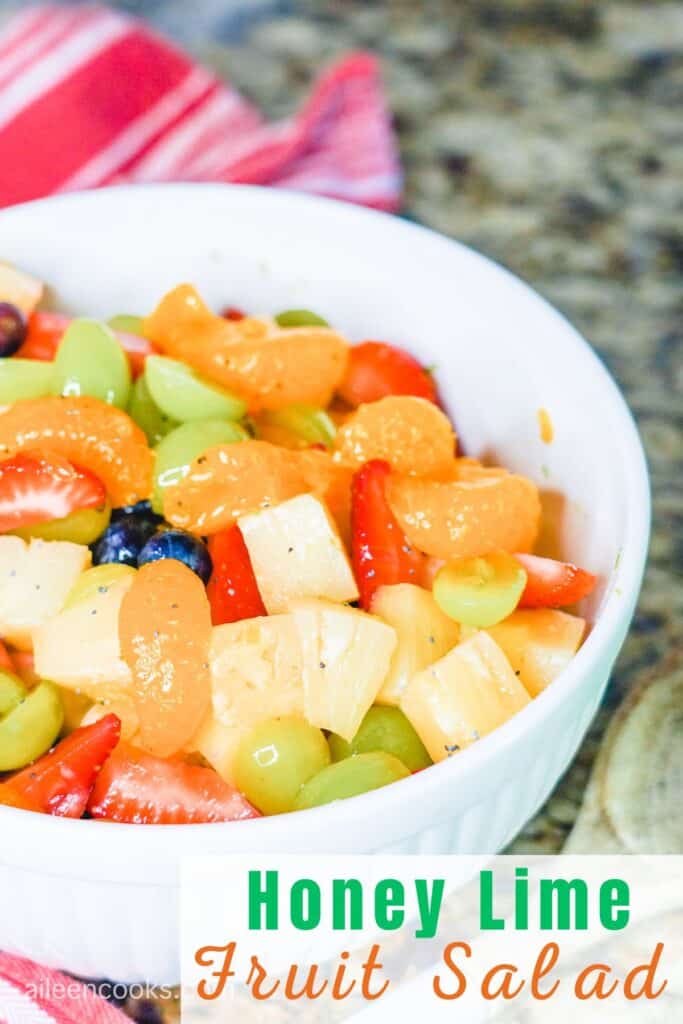
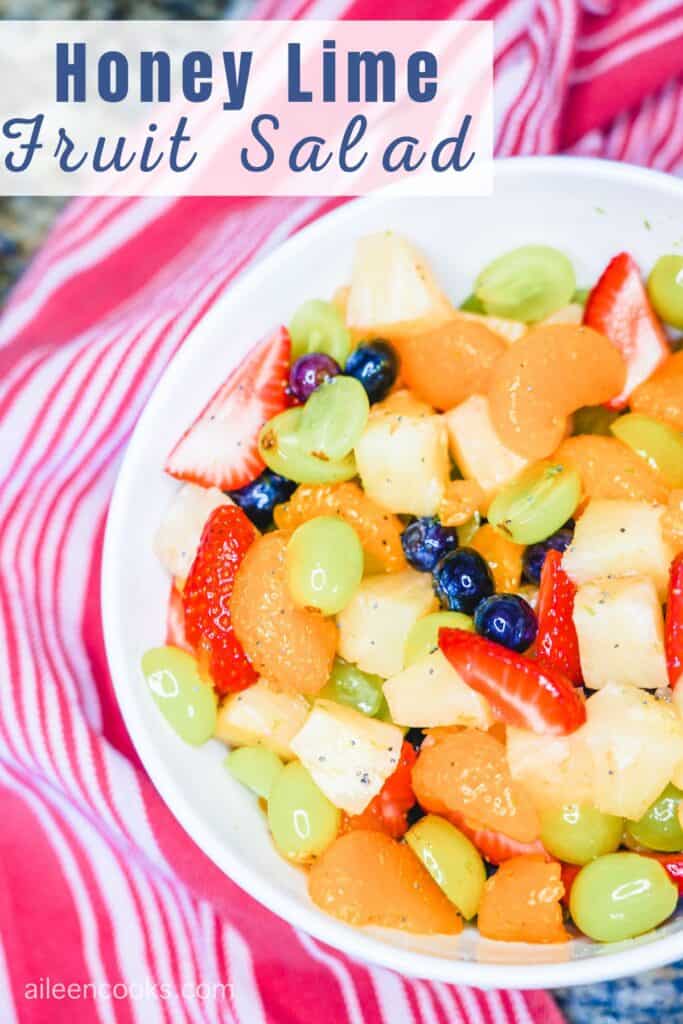
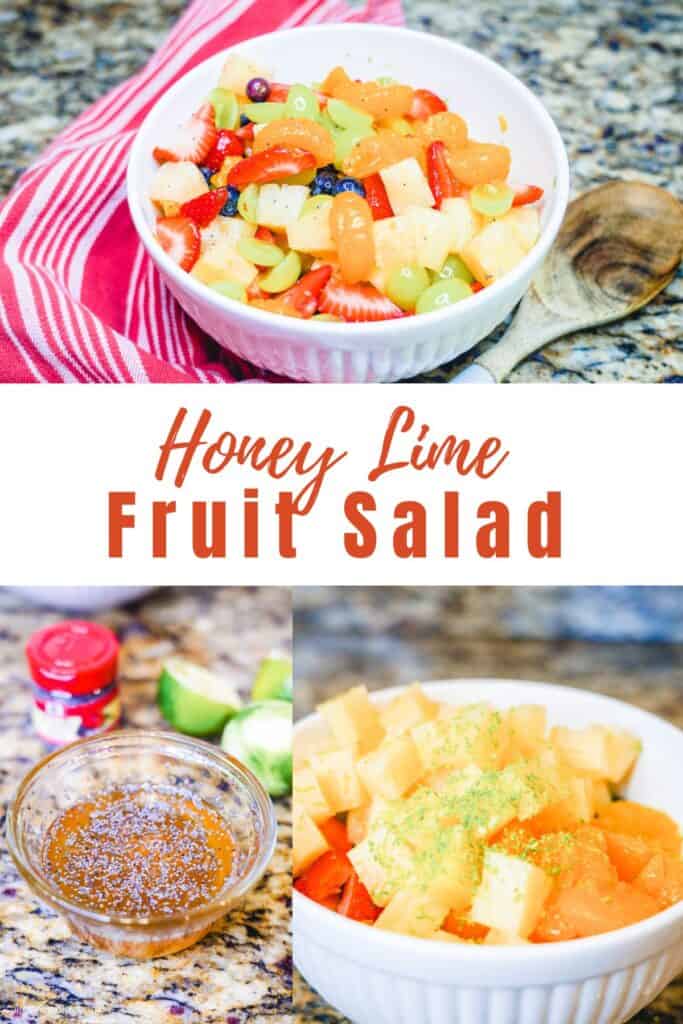
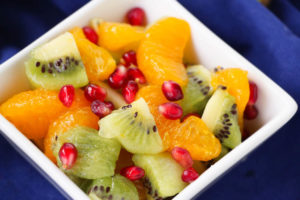
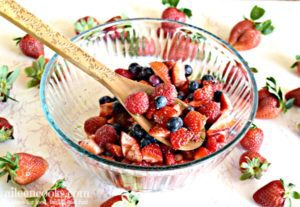



My mouth is watering! I am saving this and will make it the next time my mom’s group has a play date!
It’s always a big hit at play groups. Enjoy!
Looks soooo good. Our fruit has been sooooo $$ here that I haven’t been buying as much. I can’t wait for the prices to go down!
Shannon, our fruit prices just started to drop down here in California. Hopefully yours will start to become more affordable soon! Thanks for stopping by. 🙂